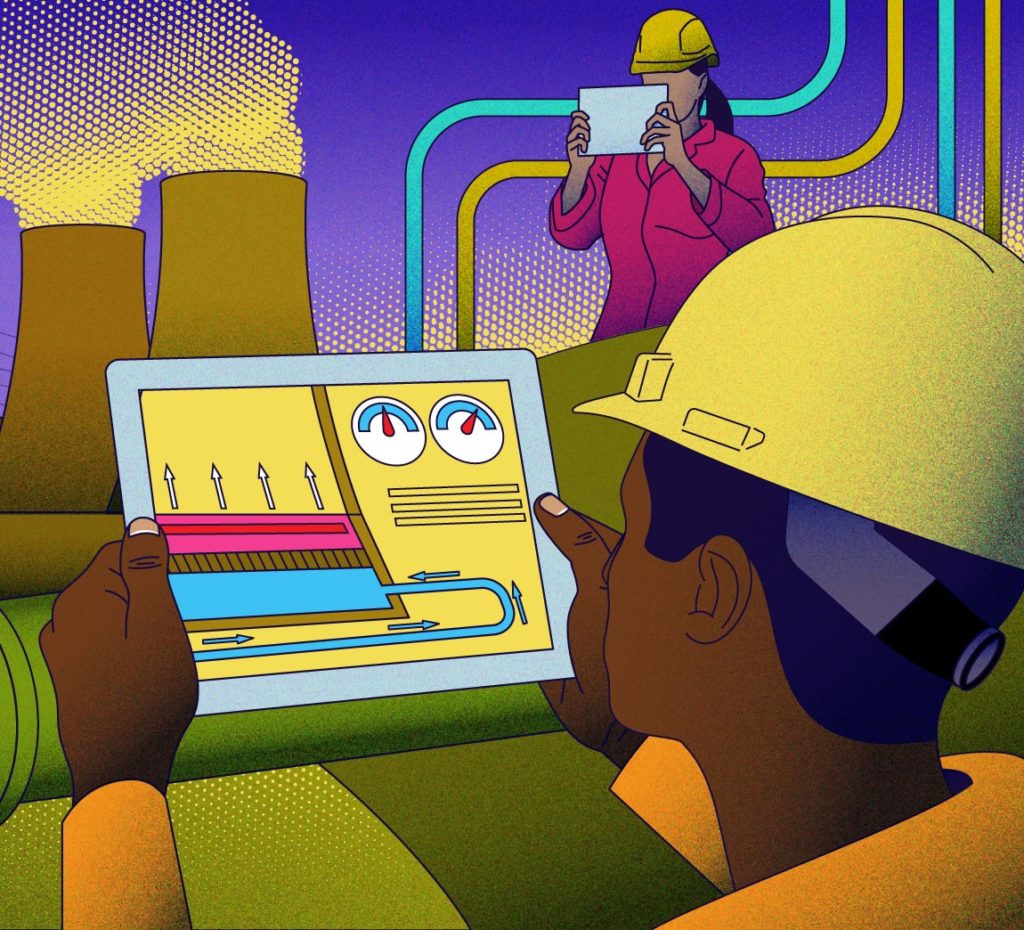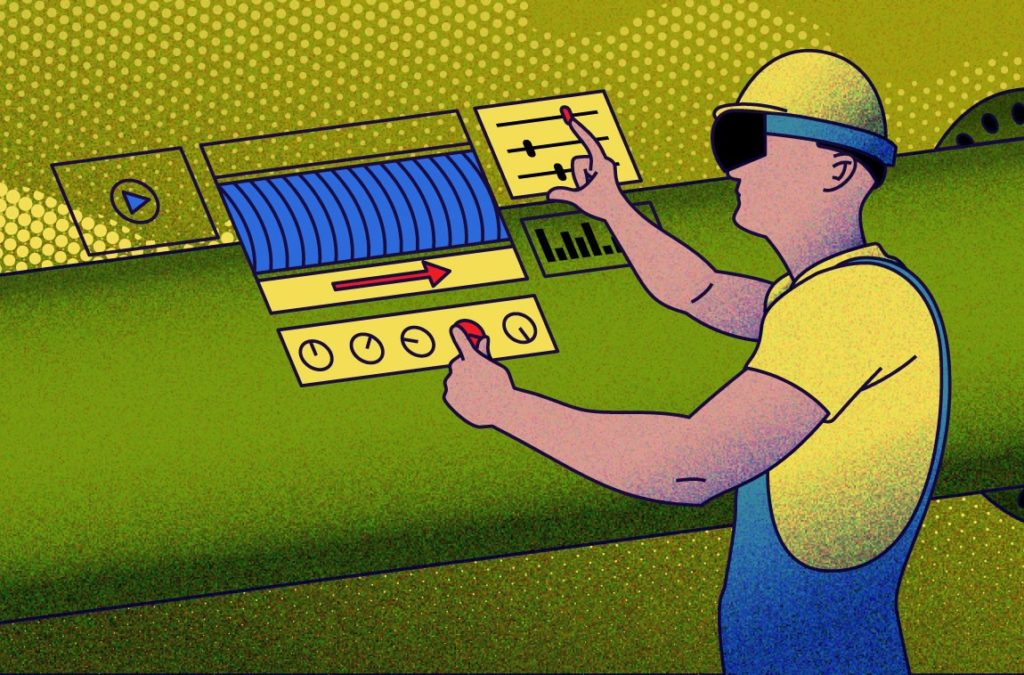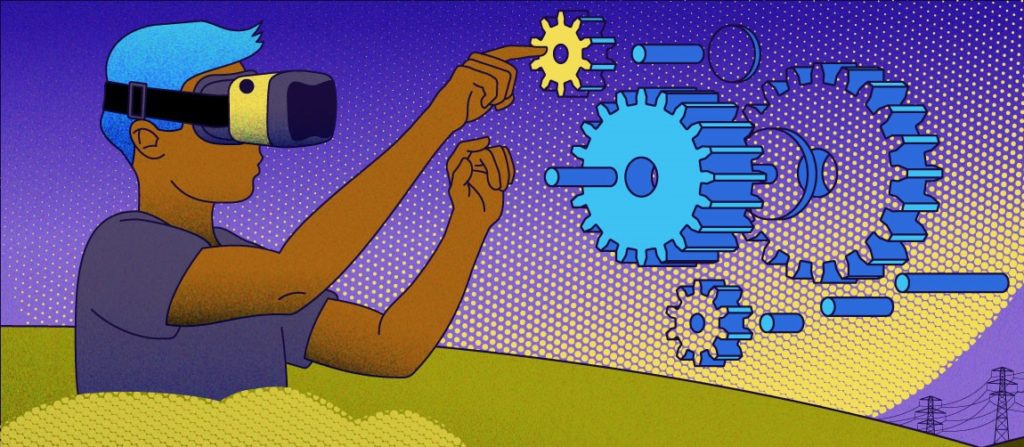New Innovation Hub Coordinates Digital Technology Research Across the Electric Power Industry
For nearly a decade, experts in EPRI’s Power Delivery and Utilization sector have been developing applications with augmented reality (AR) that utility workers can use to perform tasks on electricity transmission systems. When workers view equipment wearing glasses and headsets, descriptions, instructions, and other vital information are displayed in virtual space over the equipment. Workers use AR tools to identify transformers and other assets, assess storm damage, and report broken poles. Others remind them when to wear fire-retardant clothing at a substation.
Meanwhile, in EPRI’s Generation and Nuclear sectors, researchers are developing digital applications for workers to use in inspecting, maintaining, and repairing power plant equipment. Technicians put aside pen and paper and use a tablet or iPad to guide their work and enter data on the spot. The information is transmitted wirelessly to a central software program instead of being written on a paper form and stored in a file cabinet. According to EPRI Principal Technical Leader Nick Camilli, more than half of operating nuclear plants in the United States have transitioned to mobile platforms (such as tablets) and are using them to execute 70–85% of work orders.
These projects merely scratch the surface of how EPRI is advancing “digital worker” technologies in the electric power sector. These technologies include mobile communications, wearable computers, smart glasses, AR, virtual reality, imaging tools, and other digital technologies workers can use to perform jobs more safely, efficiently, and effectively. Widespread deployment of these technologies can improve communications, data access, real-time observations, task execution, troubleshooting, and decision making.
EPRI technical leaders from its four sectors are spearheading the Digital Worker Innovation Hub to facilitate collaboration and sharing research and best practices among various research areas. The focus is on practical applications near-term and evaluating emerging technologies.
“We are formalizing our strategy and defining how to work together across the institute to facilitate learning and to speed technology development,” said Matt Wakefield, EPRI’s director of information and communication technology. “We also want to make sure the technologies we use—as cool as they may be—are the right ones for the job.”
Among dozens of applications under development at EPRI: mobile field guides for inspecting cooling towers and steam condensers, AR-based verification for transmission switching orders, virtual reality training for turbine maintenance, AR graphics to show hazardous areas in switchyards, and electronic work packages. Researchers are also looking at the human health implications of these technologies, such as how AR impacts ergonomics and workers’ awareness of their surroundings.

“These technologies are relevant whether you work in transmission, distribution, a power plant, or are evaluating the safety of your workers in the field,” said Wakefield. “EPRI’s expertise in all these areas puts us in a good position to maximize what we learn in different sectors and not duplicate efforts.”
“EPRI is unique in that our collaboration with hundreds of utilities can provide us with information on equipment specifications, operating tolerances, and work processes,” said EPRI Engineer Micah Tinklepaugh. “These can guide the development of the most useful applications and technologies.”
As part of the Innovation Hub, EPRI is developing a comprehensive Digital Worker project database and setting up laboratories where researchers and industry stakeholders can test technologies, discuss needs, and brainstorm new applications. An interest group provides a forum for utilities to strategize, plan, and implement technologies. Insights from these activities can inform a broader power industry strategy on Digital Worker technologies.
“We want to establish EPRI as the go-to for power companies,” said EPRI Senior Technical Leader Matt Buck. “When they need Digital Worker technologies to solve a particular problem, we want them to say, ‘Let’s call EPRI and see what they’re doing.'”
A Hub for Sharing and Testing
Drawing on internal surveys and EPRI reports, Buck, Wakefield, and Tinklepaugh are gathering information about Digital Worker projects across the institute and organizing an online database to serve the interests of various groups. It can provide project details—who manages the research, how it’s funded, and what deliverables are planned. For utilities, project overviews and contact information can encourage collaboration. For the public, it can provide general descriptions of new technologies that EPRI and utilities are developing to enhance electricity service.
EPRI is setting up Innovation Labs in Charlotte and Knoxville where researchers can develop, test, and demonstrate new technologies. Each will be equipped with AR headsets, virtual reality tools, iPads, and other digital devices. The labs will also showcase areas in which utility staff and other industry stakeholders experience the technologies firsthand, learn about the benefits, and provide feedback to the developers. Additional labs are planned in Palo Alto and Washington, D.C.
“Talking to people and finding out how these technologies are working for them is important,” said Tinklepaugh.
For example, visitors can experience a new EPRI virtual reality program that trains technicians in performing Terry Turbine maintenance. Using handheld controllers, visitors manipulate tools and disassemble and reassemble the turbine in a virtual environment.
“It’s life-size,” said Buck. “You move around and reach into different areas to remove nuts and bolts and different parts of a small steam turbine.”

Can Utilities Use Digital Worker Technologies to Save Money?
To help utilities make the business case, EPRI is planning research to quantify the value of Digital Worker technologies—whether through reduced worker time, increased accuracy, or cost savings. A recent EPRI study found that line workers trained in the field with an AR app installed routers on utility poles 48% faster than workers who learned the task by reading instructions on index cards.
Another study found that an AR app could cut in half the staff time for storm damage assessment relative to conventional pen-and-paper. Based on this result, the app could potentially reduce restoration time for a typical four-day outage by 12 hours, saving customers more than $8 million.
Safety Aspects of AR
Digital Worker technologies present opportunities to improve job performance, but are they safe? For example, can the extra weight of an AR headset cause muscle strain? Can AR distract personnel working at high elevation, near high-voltage equipment, or in other potentially hazardous environments? According to an EPRI literature review, there has been little research on AR’s safety implications.
In a first-of-its-kind field study at We Energies’ Elm Road Generating Station, EPRI and Marquette University evaluated the effects of two AR devices—a full-face shield and a smaller helmet-attached unit—on 12 plant personnel as they performed routine inspection tasks. The study is being conducted through EPRI’s Occupational Health and Safety Program, part of EPRI’s Energy and Environment sector.
“The workers liked the smaller devices more because they could easily flip them out of their field-of-vision to see their surroundings,” said EPRI Principal Technical Leader Eric Bauman. “They also preferred the option of using speech to control the screens. Some noticed arm strain when they used hand gestures to control the screens.”
Researchers found that a full-face shield AR device may reduce blink rate, which can lead to eye strain. While no increase in neck and shoulder strain was observed, the tasks were brief—less than 30 seconds. An in-progress EPRI study on utility personnel performing 20-minute manhole tasks (using the same two AR devices) is expected to shed more light on AR’s potential impacts.

“EPRI is getting ahead of these ergonomic and safety issues before large-scale AR deployment occurs,” said Bauman. “AR manufacturers can use the results to improve the design of future AR devices.”
“This type of study had never been done before, so we had to design the experimental protocol from scratch,” said Richard Marklin, a Marquette University mechanical engineering professor who is working with EPRI on this research. “The study will help lead the way for other researchers to investigate these issues further. Ultimately, the research can inform utilities’ occupational safety and health guidelines for AR, such as the recommended type of AR device, duration of use, and frequency of breaks.
Capturing ‘Tribal’ Knowledge for the Younger Generation
Digital technologies can help save, store, and integrate decades of equipment maintenance data along with the knowledge of retiring utility staff. For example, one AR app enables a substation worker to direct an iPad’s camera at a component and access extensive information on its repair history and status. The app warns the worker if she is standing too close to the equipment or is in a high-voltage zone.
“These apps can incorporate tribal knowledge that a worker can take into the field,” said Buck. “It’s like having an expert looking over your shoulder.”
As an additional benefit, digital worker technologies’ “coolness” may help attract young, technologically engaged recruits.
“Relative to other technology industries, utilities may have an undeserved reputation as a boring place to work,” said Wakefield. “We’ve generated some excitement among workers who regularly use digital technologies to find nearby restaurants or constellations in the sky. The younger generation has grown up with these technologies and knows how to use them already. That may help bring them to this industry.”
According to Wakefield, it’s too early to predict how digital technologies will transform the electric power industry, but it’s not too early for vendors to develop commercial solutions.
“Some digital worker technologies could be game changers,” he said. “The opportunity to improve the way we do business is really exciting.”
EPRI Initiative to Train the Next Generation of Digital Workers
With a $6 million award from the U.S. Department of Energy, EPRI has launched the Grid-Ready Energy Analytics Training (GREAT) with Data initiative. In collaboration with utilities and universities, EPRI plans to develop professional training and university courses to enhance Digital Worker skills for the electric power industry in four areas: data science, cybersecurity, information and communication technologies, and integration of distributed energy resources such as solar, energy storage, and electric vehicles. The project will also develop certifications, credentials, qualifications, and standards for the training and education. Training includes live, in-person instruction and computer- or cloud-based digital training modules. Target audiences include engineering, applied mathematics, and computer science students and professional engineers, executives, data scientists, and other workers in the power industry.
Key EPRI Technical Experts:
Matt Wakefield, Micah Tinklepaugh, Matt Buck
For more information, contact techexpert@eprijournal.com.
Additional Resources:
- Storm Damage Assessment: Using Augmented and Mixed Reality
- Augmented Reality in Generation
- Digital Worker Innovation Hub
- Mobile Technology Guidebook: 2018 Update
- Mobile Rigger’s Handbook
- Component Maintenance Virtual Reality Application
Artwork by MCKIBILLO

